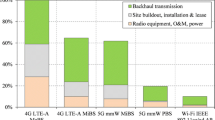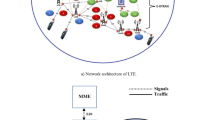Abstract
We investigate the options of a network operator who needs to reduce its carbon footprint, expressed in terms of a global energy cap. First, we propose two ways to meet the energy limitations: by efficiently managing the energy consumed by the legacy networks or by installing additional capacity to the initial topology. We show the power savings that can be obtained in both cases as well as the incurred costs. Then we identify the initial composition of the network and the available technology in the upgrade phase as the factors that have the most influence on the ability of a network to meet the energy caps. Finally, we show the intrinsic unfairness of the energy caps, which are imposed to all the networks without taking into account the differences among them. In conclusion, we highlight the fundamental role of carbon markets and emission trading systems to guarantee a measure of fairness between the operators.
Similar content being viewed by others
References
Auer, G., Blume, O., Giannini, V., Godor, I., Imran, M.A., Jading, Y., Katranaras, E., Olsson, M., Sabella, D., Skillermark, P., & Wajda, W. (2011a). D2.3 v2: Energy efficiency analysis of the reference systems, areas of improvements and target breakdown. Tech. rep., INFSO-ICT- 247733 EARTH (Energy Aware Radio and network TecHnologies).
Auer, G., Giannini, V., Godor, I., Skillermark, P., Olsson, M., Imran, M., Sabella, D., Gonzalez, M., Desset, C., & Blume, O. (2011b). Cellular energy efficiency evaluation framework. In 73Rd vehicular technology conference (VTC), IEEE (pp. 1–6).
Boiardi, S., Capone, A., & Sansò, B. (2013). Radio planning of energy-aware cellular networks. Computer Networks, 57, 2564–2577.
Boiardi, S., Capone, A., & Sansò, B. (2014). Planning for energy-aware wireless networks. IEEE Communications Magazine, 52(2), 156–162.
Chiaraviglio, L., Mellia, M., & Neri, F. (2008). Energy-aware networks: Reducing power consumption by switching off network elements. In FEDERICA - Phosphorus tutorial and workshop (TNC2008).
Correia, L., Zeller, D., Blume, O., Ferling, D., Jading, Y., Gódor, I., Auer, G., & Van der Perre, L. (2010). Challenges and enabling technologies for energy aware mobile radio networks. IEEE Communications Magazine, 48(11), 66–72.
De Domenico, A., Calvanese Strinati, E., & Capone, A. (2014). Enabling green cellular networks: A survey and outlook. Computer Communications, 37, 5–24. doi:10.1016/j.comcom.2013.09.011.
Fehske, A., Fettweis, G., Malmodin, J., & Biczok, G. (2011). The global footprint of mobile communications: The ecological and economic perspective. IEEE Communications Magazine, 49(8), 55–62.
Hasan, Z., Boostanimehr, H., & Bhargava, V.K. (2011). Green cellular networks: A survey, some research issues and challenges. IEEE Communications Surveys & Tutorials, 13(4), 524–540.
Hata, M. (1980). Empirical formula for propagation loss in land mobile radio services. IEEE Transactions on Vehicular Technology, 29(3), 317–325.
ITU International Telecommunication Union (2007). ICTs and climate change. http://www.itu.int/ITU-T/newslog/ICTs+And+Climate+Change.aspx , ITU-T Technology Watch Report 3, December 2007.
Marsan, M.A., & Meo, M. (2010). Energy efficient management of two cellular access networks. ACM SIGMETRICS Performance Evaluation Review, 37(4), 69–73.
Niu, Z., Wu, Y., Gong, J., & Yang, Z. (2010). Cell zooming for cost-efficient green cellular networks. IEEE Communications Magazine, 48(11), 74–79.
NOAA National Climatic Data Center (2014). State of the climate: Global analysis for annual 2014. http://www.ncdc.noaa.gov/sotc/global/2014/13, published online January 2015.
NRC National Research Council. (2010). Advancing the science of climate change. Washington: The National Academies Press.
Schneider, S. (1998). Kyoto protocol: the unfinished agenda. Climatic Change, 39(1), 1–21.
The Climate Group (2008). SMART 2020: Enabling the low carbon economy in the information age. Tech. rep., Global e-Sustainability Initiative.
Wang, X., Vasilakos, A., Chen, M., Liu, Y., & Kwon, T. (2012). A survey of green mobile networks: Opportunities and challenges. Mobile Networks and Applications (MONET), 17(1), 4–20.
Author information
Authors and Affiliations
Corresponding author
Rights and permissions
About this article
Cite this article
Boiardi, S., Capone, A., Girard, A. et al. Insight into the impact of energy caps on the costs of cellular networks with different layouts and technologies. Netnomics 17, 95–120 (2016). https://doi.org/10.1007/s11066-016-9103-5
Accepted:
Published:
Issue Date:
DOI: https://doi.org/10.1007/s11066-016-9103-5




